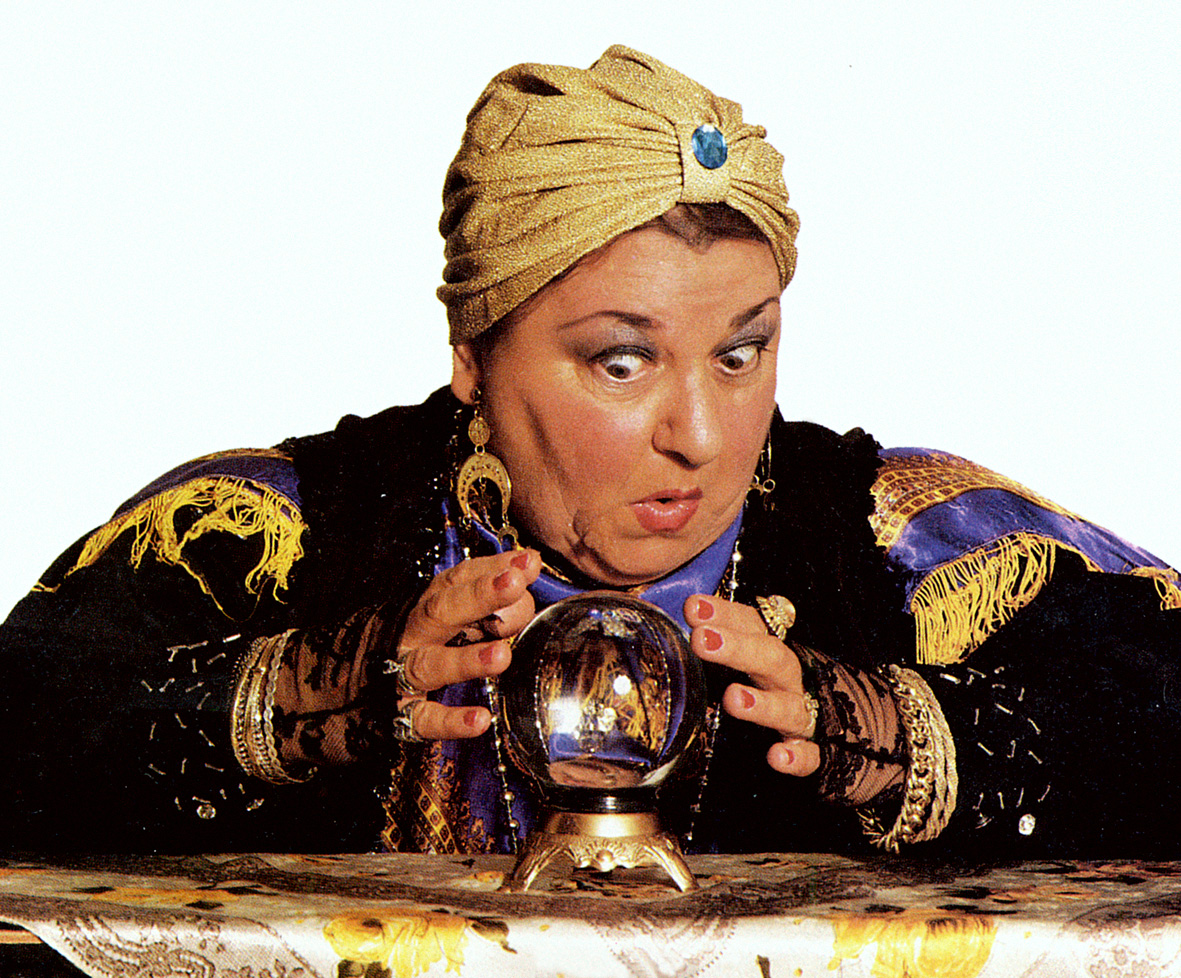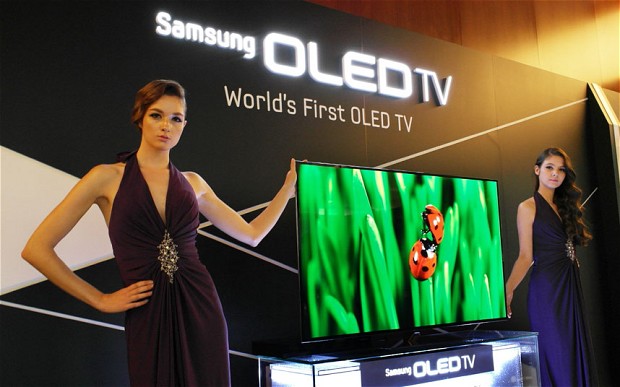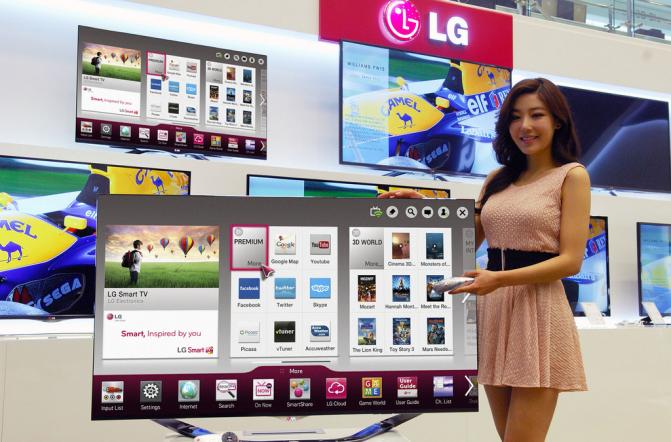The future of TV according to Appliances Online: OLEDs, Ultra High Definition … and more!
February 4th, 2013
 Okay, it’s time for Appliances Online to turn its gimlet eye to the future.
Okay, it’s time for Appliances Online to turn its gimlet eye to the future.
We’ll adjust the vertical hold on our crystal ball … there we go …. and ignoring the election results (apparently, the Greens will win) and fashion trends (it looks like flares are coming back), we’re going to take a gander at the prospects for flat-screen television!
We’ll use what we’ve learned recently via the CES (short for Consumer Electronics Show, held in the lil’ town of Las Vegas recently) – and various other bits of research, know-how, guess-work and voodoo – to give our take on the soon-to-be-latest-and-greatest trends in the devastatingly exciting and interesting world of flat-panel television.
4K Ultra HD resolution the future?
Yes, in our opinion, this technology will be a major player in the marketplace – within the next couple of years.
For ya’ll who might not be familiar with the definition “4K”… here’s the goss: it’s also known variously as “Ultra HD” or “4K Ultra HD”. What’s in a name? – well, the salient point is that 4K offers four times as much image resolution as Full High Definition.
So, yeah, remember all those times we told you that Full High Definition was the “ultimate” resolution and basically the last word in screen technology? Well, uh … about that, just pretend we never said that.
Having beheld 4K with our own peepers at the CES, we are fans: there’s a richness of detail that delivers a mightily amazing in-your-face and immersive experience…
… something we think will put it in a position to seriously rival 3D. And it provides its thrills minus the pesky glasses.
At the moment, prices are a little fierce (the price on 84-inch displays from Sony will be somewhere around the $20,000-$25,000 mark in Australia), but we expect it to become very much more affordable over the next couple of years.
4K game-changers
More content:
Sure, the dearth of 4K content – the fact there is so little stuff out there that you can actually watch on these screens – is a bit of a nutty issue. But there are a couple of indications things will turn around. Give them time – for example, Sony used the CES as a platform to tell us they will be launching the first 4K Video Distribution Service. Sony is also notable for having lead the way in successfully remastering classic films, such as Bridge On The River Kwai and Taxi Driver, into 4K.
 But much more will need to be done. Pushing out the content is expensive – encoding technology, in particular. And with broadcasters unwilling to invest in 4K until becomes more cost-effective, we suspect it’ll be a while before it becomes commercially viable to televise the stuff.
But much more will need to be done. Pushing out the content is expensive – encoding technology, in particular. And with broadcasters unwilling to invest in 4K until becomes more cost-effective, we suspect it’ll be a while before it becomes commercially viable to televise the stuff.
4K resolution up-conversion:
In the meantime, several manufacturers are getting on the front foot and adopting a DIY attitude when it comes to 4K. Responding to the lack of native 4K content, they’ve been busy developing up-conversion technology that gives bog-standard Full HD 1080p resolution a kick up the ass, quality-wise.
For example, Sharp unveiled their next generation of Quattron TVs at CES 2013, which included specialised signal processing for scaling images up from 1080p to 4K. And then there was LG with something called Resolution Upscaler Plus attached to their 84LM960V.
None of this will actually create true 4K, but by using the available pixels that an Ultra HD TV has on offer, you’ll get a viewing experience that’s tangibly better than Full HD. By bridging the gap between the two resolutions in this way, it’s a big step toward improving the chances of the new wave of TVs.
Is OLED the future?
OLED was another technology that really impressed us at this year’s CES – and we also think it has legs (and it knows how to use them). Expect it to be THE king of flat-panel technology sometime soon. We had a chance to get up-close and personal with them … and we’re definite converts.
What is OLED?
Stands for Organic Light Emitting Diodes. A (not-at-all) catchy way of encapsulating what we think could actually be the ultimate viewing experience around (uh, until something better comes along, later).
An OLED uses carbon-based organic materials – held in place between two conductors – that emit light when applied with an electric current. Unlike LCD/LEDs, they don’t require backlights or colour filters – which has the following advantages:
• Faster refresh rates, improved contrast and better colour reproduction
• Improved viewing angles
• More environmentally friendly: drawing less power and containing no toxic metals
• Incredibly thin and lightweight units
As of now, the only crimp on our overwhelming love for ’em (and it’s more than a bit of a problem, we’ll admit) is the extreme expense and general availability of them.
However, we can say that LG will be set to bring a selection of their OLED TVs to these shores this year – and that, as a general statement, OLEDs are on their way.
Smart(er) TVs
The near future will see some amazingly dynamic improvements to Smart functionality.
We witnessed spectacular developments, for example, in voice control at the CES. Manufacturers have been working hard to develop the capacity to respond to the natural flow of dialogue – alleviating the need give orders like a constipated Dalek.
Samsung, for example, has been working in cahoots with Sydney’s Macquarie University to develop a full understanding of the quirks of the Aussie vernacular … this will ensure their release of 85” Ultra HDTVs, won’t encounter any language barrier when it hits these shores (arrival is anticipated in the first half of this year).
Intuitive Technology
 Even cooler (well, okay, as cool as TVs get), we will see more intuitive technology emerging.
Even cooler (well, okay, as cool as TVs get), we will see more intuitive technology emerging.
For example, LG have updated their amazingly Freudian Magic Remote, so that it can now process questions – for example, “find me the third season of Mad Men” … or “find me that episode of Jersey Shore where Snooki got arrested” – delivered in a natural way.
It will then be able to find that content by conducting its own search across the LG Smart TV platform – search engines, external devices … and more. Then deliver it to you, without any fuss.
Technology that knows what you like
Get set for technology that is able to respond to what you like to watch and help you personalise your viewing experience. More intuitive and more in-tune with the essential you, kids.
Panasonic for example, were touting what they called My Home Screen, which will let each member of the household create a home page with their own content preferences. That extends to having facial recognition technology that’ll enable your TV to figure out who’s watching it … and organise content according to your preferences and viewing habits.
And then there’s Samsung’s updated Smart Hub function – which offers an ultra-slick user interface providing content suggestions … that will even depend on how your viewing habits change during the course of the day.
We see this as an important and popular step forward – hey, it’s difficult to sort the jewels from the junk with the glut of available content out there. This technology will make it so much easier to get to what you really want to watch.
Top TV innovations
That’s our take on the major trends in TV technology, but there were a couple of other developments that made us sit up and take notice (or at least, stay lying down but STILL take notice). While these can’t be considered trends per se, we see definite potential for them in the next coupla years. It’s worth giving them a shout-out.
Built-in speakers that actually kick ass
Sony pushed the boat out the CES with TVs that come with integrated speakers … which actually sound pretty damn good. Included on the Sony 55- and 65- inch 4K displays (XBR-55X900A and XBR-65X900A), these things impressed us with their ability to pump out the kind of sounds that would normally be expected from a reasonably high-end dedicated set of speakers.
If and when 4K works its mojo on the public at large, the fact Joe Bloggs knows he can invest in a Sony TV without having to worry about buying a set of speakers to go with it will be a major plus.
TV Upgrade Kits
Samsung’s Evolution Kits are one of our favourite innovations – basically letting you get an upgraded TV experience, without the cost of forking out for a new TV. In appearance a small, rather unremarkable black box … however attached to select models from the 2012 range of Samsung TVs, it will deliver enhanced processing power, software changes and more memory – in line with the 2013 generation of TVs. We can’t help thinking this is a flat-out awesome idea – and we’d love to see the concept, or something similar, becoming more widespread.







Leave a Reply